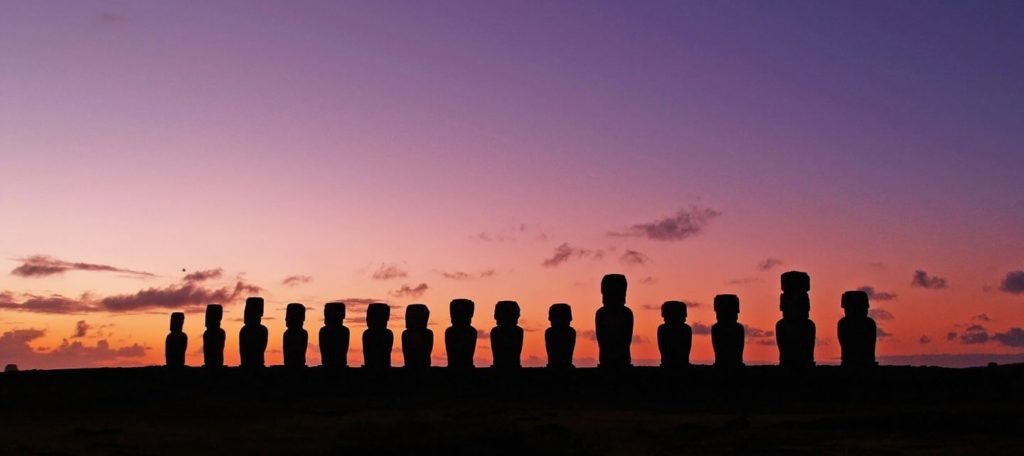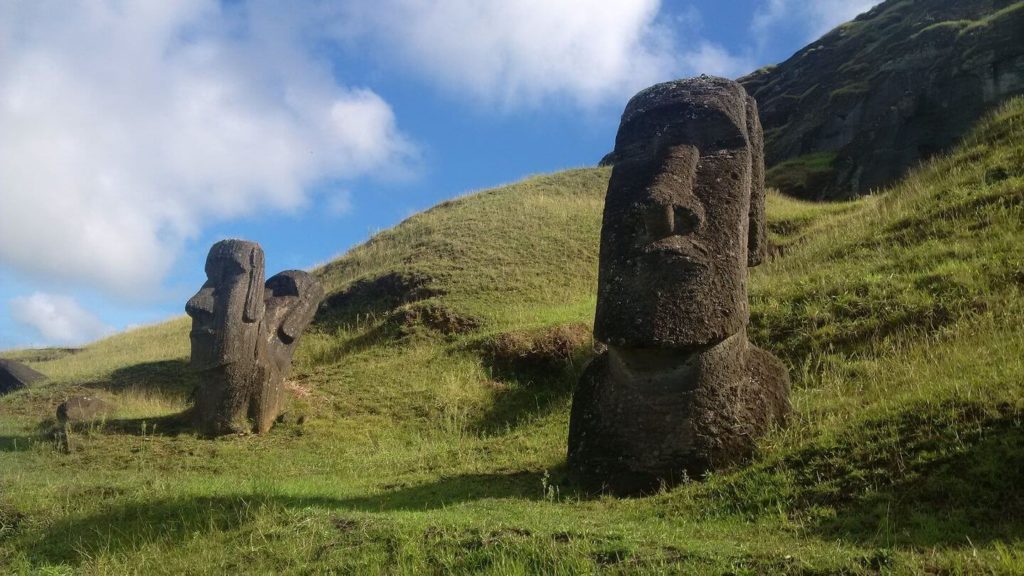Recently updated on July 31st, 2023 at 04:05 pm
With an enigmatic past that’s yet to be fully unlocked, Easter Island (Rapa Nui) is a beautiful island filled with mystery and magic. Historians and scientists have spent decades trying to understand the geology and culture of the island and decipher the meaning behind the giant moai statues built by the early Rapa Nui people. From the origins of the first inhabitants to the discoveries on the ‘Easter Island heads’, we look at 6 of the most fascinating Easter Island facts.
1. Easter Island has a few different names
When Dutch admiral Jacob Roggeveen became the first European to land on this remote island on Easter Sunday in 1722, he named it ‘Paasch-Eyland’ (Dutch for ‘Easter Island’) in tribute.
However, the indigenous name for Easter Island is ‘Rapa Nui’ (Great Rapa). The island’s indigenous population use this name for their island, and the locals are also known as the Rapa Nui. There is also an older name for the island – ‘Te Pito O Te Henua’, meaning ‘The World’s Navel’. There is a theory that the name ‘Rapa Nui’ was conceived in the mid-19th century when Peruvian slave raiders compared the island to the Rapa island in French Polynesia.
RELATED CONTENT: No Latin America bucket list is complete without these 5 experiences
2. Easter Island is the world’s most secluded inhabited island


Lying in the southeastern Pacific Ocean, 3,800 kilometres off the coast of its nearest neighbour Chile, Easter Island is among the world’s most remote inhabited islands. It remains a territory of Chile, but it still takes at least five hours to get to Easter Island! The only way to get there is by plane, as it doesn’t even have any harbours. The shortest flight is five hours from Santiago, and you can also fly there in seven hours from Tahiti.
So what are the benefits of being so far away? Well, peace and quiet for starters! Easter Island is also largely free from pollution and a fun fact is that it’s home to some of the clearest ocean waters in the world. The water around the island is transparent up to a depth of 50 to 60 metres. It’s an oasis for snorkelers and divers who marvel at the colourful corals and sea life beneath the surface.
RELATED CONTENT: Where to sip the best Chilean wine in Chile
3. A Polynesian chief first settled the island hundreds of years ago


Legend says that the intrepid chief Hotu Matu’a led his people to Easter Island anywhere from 800 to 1,700 years ago. The chief and his people were from the mythological Polynesian island of Hiva (now believed to be the Marquesas Islands) and sailed to Easter Island on large canoes. They settled on the island, introducing new species like bananas, sugarcane and chickens, and lived far away from the rest of the world for generations until European explorers arrived.
There is believed to have been a thriving population of a few thousand living on the island for many years. However, after devastating civil wars, epidemics, slave raids, famine and deforestation, there were just 111 people remaining by 1877. Today there are around 8,000 people living on the island, and almost half consider themselves indigenous Rapa Nui.
GET INSPIRED BY: South America Landscapes
4. The moai are believed to represent Rapa Nui ancestors
One of the most iconic elements of Rapa Nui culture is the massive moai – the huge stone sculptures that represented the faces of worshipped ancestors. The bodies are buried underneath the ground with only the face and shoulders above ground. All face inward from the coastline to symbolise protection for everyone.
There were originally thousands of these enormous moai statues on Easter Island, however at some point in the 1700s, there were civil wars between the Rapa Nui. As the clans fought over scarce resources, they also tore down each other’s moais. Some moai were also stolen by collectors before the island was declared a UNESCO World Heritage Site in 1995. Many have since been re-erected on Easter Island which you can see today. You can also observe these fascinating figures in the Louvre in Paris and the British Museum in London. The largest moai on Easter Island can even be seen from Google Earth!
There are many Easter Island fun facts and theories about the famous moai. They were originally known as ‘Easter Island heads’ before archaeologists discovered the statues have bodies in 1914. The giant heads are already impressive enough, and it’s incredible to imagine just how big these statues are with bodies too! Also, some of the moai have pukao (a hat-like object on their heads). Some theories say it represents hair, while others say it’s a symbol of power.
RELATED CONTENT: Your questions answered: Is Patagonia better in Chile or Argentina?
5. The Rapa Nui moved the moai statues up to 18km – but how?
The moai are big – and solid. They were carved with stone chisels by the islanders from solidified volcanic ash, found on the island’s Rano Raraku volcanic crater. So how did they move these massive statues around the island? No one really knows, as there’s no written history and only the stories passed along between generations.
However, considering that the average height of the moai is four metres, with a width of 1.6 metres and a weight of around 12.5 tonnes (the weight of two African elephants!), it must have been a truly remarkable feat to move the moai around 18 kilometres across the island.
Some theories say that the islanders used a combination of ropes, log rollers and wooden sledges. However, scientists in 2011 proved that just 18 people could move a three-metre replica moai weighing five tonnes with three strong ropes and some practice. It’s not clear if this method would have worked on Paro, the tallest moai ever created at almost 10 metres in height and 82 tonnes in weight, or the heaviest moai which weighs a staggering 86 tonnes.
RELATED CONTENT: Five Reasons to Visit Chile
6. Easter Island holds the Tapati Rapa Nui Festival every year
The inhabitants of Easter Island celebrate their culture every year with the Tapati Rapa Nui Festival. It’s held during the first two weeks of February with traditional activities like wood carving and music played on unique eight-string flat ukuleles.
The island also splits into two teams during the festival. Both teams are led by a queen, and the winning team’s queen is crowned ‘Queen of the Island’ for the rest of the year. The whole festival is a fantastic event and a wonderful time of year to visit this extraordinary island.
Do you know any interesting facts about Easter Island? Let us know in the comments below!